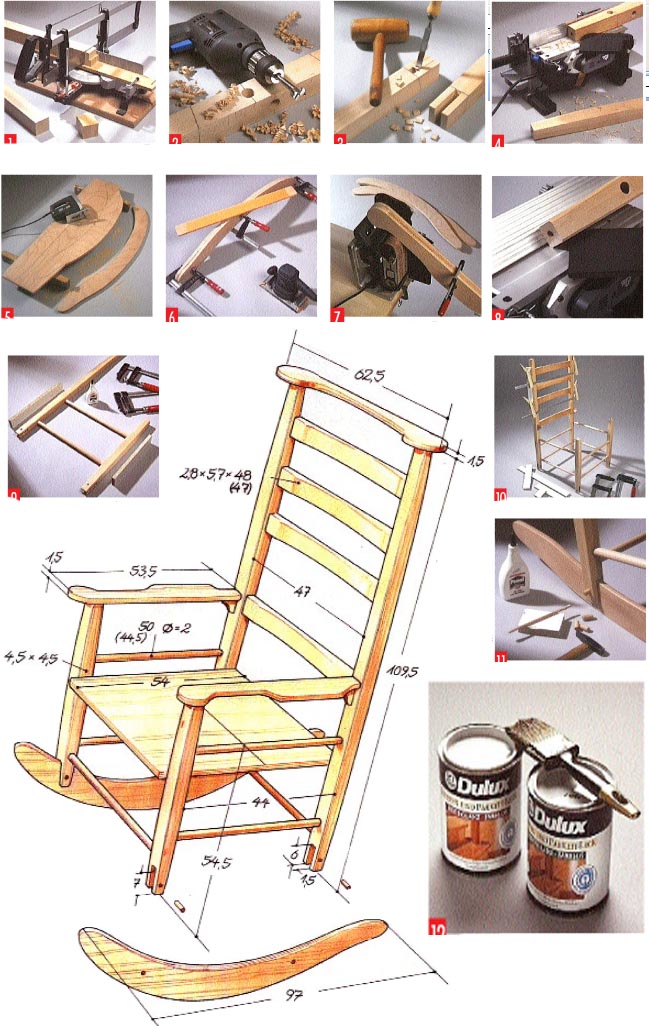 You can follow in the photos on the right, how the rocking chair is made from solid beech wood and multiplex plywood. It starts with gluing the rectangular strips together to form square leg rails and ends with gluing the entire rocking chair. You can see it well, what hand- or power tools we have used for the individual work steps: equipment, each of which ensured optimal work progress. Of course, some work can also be done with simple hand tools. For example, planing the leg rejuvenation. Other jobs such as shaping the cross-pieces of the backrest require a power tool. You might have to get what is missing.
You can follow in the photos on the right, how the rocking chair is made from solid beech wood and multiplex plywood. It starts with gluing the rectangular strips together to form square leg rails and ends with gluing the entire rocking chair. You can see it well, what hand- or power tools we have used for the individual work steps: equipment, each of which ensured optimal work progress. Of course, some work can also be done with simple hand tools. For example, planing the leg rejuvenation. Other jobs such as shaping the cross-pieces of the backrest require a power tool. You might have to get what is missing.
All connections remain at right angles, otherwise it would ! too complicated. The curly forms are then something for the eye. You will find a lot more information including a detailed parts list on our construction plan.
We obtained the solid rectangular strips made of beech wood as planed goods from the timber dealer. They were there too 20 mm thick beech dowel rods. However, not all of them were true to size, in particular. We checked their diameter with a calliper and only selected bars that were exactly round. But we also had to look closely at the rectangular strips, so as not to catch any bent or twisted pieces. To be on the safe side, buy a little more material and cut out existing faults.
The leg spars are cut to the correct angle either with a precision miter saw or on a table saw. Mark out the lengths exactly according to the parts list.
The holes for the crossbars, which consist of 20 mm beechwood rods, are made under the drill stand. The depth of the blind holes: exactly 30 mm.
The lower ends of the chair legs for the plywood runners are sawn in to the target depth. Chisel out the slot with the chisel on both sides up to the middle. An electric planer with a stationary bracket makes it easy for you, to taper the leg spars evenly towards the ends. With the hand plane, the work is more difficult.
Multiplex plywood in beech, 15 mm dick, is the material, from which the runners and backrests are made. Record contours, Saw out with a jigsaw.
The underside of the runner, Slightly uneven from the saw cut, smooth with a long, sandpaper-covered bar. Smooth the top edge and sides with the orbital sander.
The curly forms of the arm- and the backrests can be reworked with a stationary belt sander. Clamp workpieces together in pairs. You can chamfer the rocking chair legs cleanly, if you set the side fence of the stationary planer to a 45-degree angle. Then finish with sandpaper. Two long servants and a few stable allowances (coated panel strips) Do you need, to connect the two sides of the chair permanently and firmly with wood glue.
A helper should be on hand to help you glue the chair frame and backrest together. Place the chair legs on a flat surface, underlay the constraints with allowances.
The rocking chair runners, placed in the slots according to the plan, will be there with one each 12 mm thick, glued-in wooden dowels. Apply glue to the contact areas as well.
A staircase- and parquet varnish with a very scratch-resistant surface was used to seal the wood. Choose between a high-gloss or semi-gloss finish.